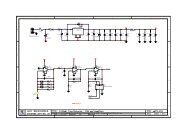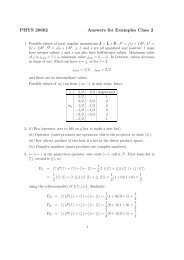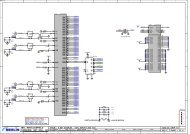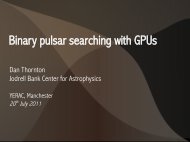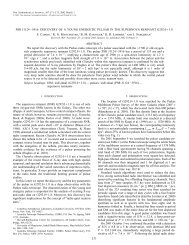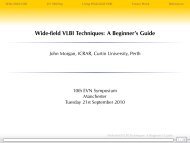PHYS 20171 MATHEMATICS OF WAVES AND FIELDS Lecturer ...
PHYS 20171 MATHEMATICS OF WAVES AND FIELDS Lecturer ...
PHYS 20171 MATHEMATICS OF WAVES AND FIELDS Lecturer ...
Create successful ePaper yourself
Turn your PDF publications into a flip-book with our unique Google optimized e-Paper software.
<strong>PHYS</strong> <strong>20171</strong> <strong>MATHEMATICS</strong> <strong>OF</strong> <strong>WAVES</strong> <strong>AND</strong> <strong>FIELDS</strong><br />
<strong>Lecturer</strong>: Gary Fuller<br />
Room: Turing Building 2.311<br />
Email: G.Fuller@manchester.ac.uk<br />
Phone: 0161-306-3653<br />
The aim of this course is to develop some of techniques needed to solve linear partial<br />
differential equations (PDE’s). These equations appear in many areas of physics and<br />
describe waves and fields which can vary in one or more space dimensions and in time.<br />
They include:<br />
• Laplace’s equation<br />
∇ 2 φ(r) = ∂2 φ<br />
∂x 2 + ∂2 φ<br />
∂y 2 + ∂2 φ<br />
∂z 2 = 0<br />
The field φ(r) could be, for example, the electrostatic potential in a region of space<br />
without electric charge, or the steady-state distribution of temperature inside some<br />
body.<br />
• The ordinary (or nondispersive) wave equation<br />
∇ 2 φ(r) = 1 c 2 ∂ 2 φ<br />
∂t 2<br />
This describes waves with a constant speed c. These could be sound waves, if φ(r, t)<br />
is the displacement of a vibrating string or membrane or medium. They could also<br />
be electromagnetic waves, such as light or radio, if φ(r, t) is one of the components<br />
of the electric field.<br />
• The Schrödinger equation<br />
− ¯h2<br />
2m ∇2 ψ(r, t) + V (r)ψ(r, t) = i¯h ∂ψ<br />
∂t<br />
This is the central equation of quantum mechanics. It describes the quantum mechanical<br />
wave for a particle of mass m moving in a potential V (r). The wave<br />
function ψ(r, t) gives the probability amplitude for finding the particle at the point<br />
r at time t.<br />
• The heat-flow (or diffusion) equation<br />
∇ 2 φ(r, t) = 1 D<br />
This describes the flow of heat inside a body with no internal source of heat; the<br />
field φ(r, t) is the (time-dependent) temperature distribution inside the body.<br />
∂φ<br />
∂t<br />
1
Recommended books<br />
The recommended books for this course is:<br />
• M. L. Boas, Mathematical methods in the physical sciences, 3rd edn., (Wiley,<br />
2006). Material in: Chapter 7, Sections 5, 10 and 11 of Chapter 8, Chapter 12, and<br />
Chapter 13. This book will provide the necessary mathematical backup for your<br />
physics courses over the next two or three years.<br />
• K. F. Riley, M. P. Hobson and S. J. Bence, Mathematical Methods for Physics<br />
and Engineering (Cambridge, 1997) Chapters 10, 11, 13.1, 14, 15, 16 and 17.<br />
Another useful book, on applications of these ideas to PDE’s, is: G. Stephenson, Partial<br />
differential equations for scientists and engineers (Imperial College, 1996).<br />
Webpage<br />
http://www.jb.man.ac.uk/∼gaf/lecture/phys<strong>20171</strong>.html<br />
and Blackboard page.<br />
2
Course outline<br />
References to book chapters or sections, as follows:<br />
B3 Boas, 3rd edition<br />
B2 Boas, 2nd edition<br />
R+ Riley, Hobson and Bence<br />
Examples of partial differential equations in physics<br />
B3 and B2 13.1; R+ 16.1<br />
0. Ordinary differential equations (∼ 1 lecture)<br />
B3 and B2 8.5, 2.9, 2.11, 2.12; R+ 13.1<br />
First-order, linear<br />
Second-order, linear<br />
Complex exponentials<br />
1. Wave problems in one dimension (∼ 2 lectures)<br />
B3 and B2 13.2 (separation of variables), 13.4; R+ 16.1.1, 17.1, 17.2<br />
Separation of variables<br />
Normal modes of a string: eigenfunctions and eigenvalues<br />
General motion of a string<br />
2. Fourier series (∼ 4 lectures)<br />
B3 and B2 7.1–7.11; R+ 10<br />
Orthogonality and completeness of sines and cosines<br />
Fourier coefficients<br />
Complex exponential form of Fourier series<br />
Initial conditions on PDE’s<br />
3
3. Other PDE’s (∼ 2 lectures)<br />
B3 and B2 13.2, 13.3; R+ 16.1.2, 16.1.3, 17.2<br />
Laplace’s equation<br />
The heat-flow equation<br />
4. Integral transforms (∼ 3 lectures)<br />
B3 7.12, 8.10, 8.11; B2 15.4, 15.5, 15.7; R+ 11.1<br />
Fourier transform<br />
Convolutions<br />
Wave packets and dispersion<br />
5. Series solution of ODE’s (∼ 4 lectures)<br />
B3 and B2 1.6C, 1.10, 1.12, 12.2, 12.6, 12.7–12.9, 12.11, 12.12;<br />
R+ 3.3, 3.6, 14.2, 14.3, 14.6, 14.7<br />
Taylor series<br />
Legendre polynomials and related functions<br />
Bessel functions<br />
Orthogonal sets of eigenfunctions<br />
Legendre series<br />
6. Problems in two and three dimensions (∼ 6 lectures)<br />
B3 and B2 13.5–13.7; R+ 17.3<br />
Normal modes of a square membrane; degeneracy<br />
Wave guide<br />
Normal modes of a circular and spherical systems<br />
Heat flow and Laplace’s equation in circular and spherical systems<br />
4



